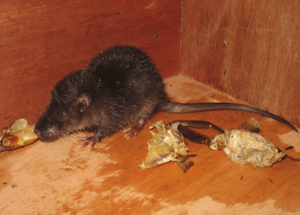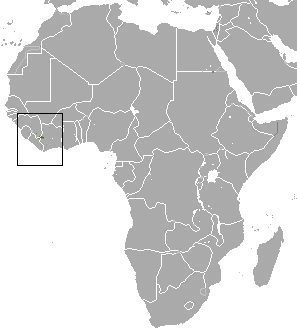Nimba otter shrew facts for kids
Quick facts for kids Nimba otter shrew |
|
|---|---|
 |
|
| Conservation status | |
| Scientific classification | |
| Genus: |
Micropotamogale
|
| Species: |
lamottei
|
 |
|
| Nimba otter shrew range | |
The Nimba otter shrew (scientific name: Micropotamogale lamottei) is a small, unique mammal. It's a type of otter shrew, which are related to shrews and found in Africa. Otter shrews are part of a group of mammals called afrotherians. They live in Africa, south of the Sahara Desert. Surprisingly, their closest relatives are tenrecs, which live far away on the island of Madagascar!
This particular shrew is called Micropotamogale, which means "tiny river weasel." That's a great name because it's small and loves rivers! You can find it only in the Mount Nimba area. This special mountain region is located where the countries of Liberia, Guinea, and Côte d’Ivoire (also known as Ivory Coast) meet in West Africa.
Contents
What Does It Look Like?
The Nimba otter shrew is a small animal. It weighs about 125 grams, which is like a small apple. Its body is about 15 to 22 centimeters long. Its tail makes up about a quarter to a third of its total body size.
People have described it as a "miniature sea otter with a rat tail." Its fur, called pelage, is long and thick. This long fur hides its ears and eyes. The fur is usually brown, but some otter shrews have been seen with black or gray fur.
Life in the Wild
The Nimba otter shrew is a nocturnal animal. This means it is most active at night. It is also semiaquatic, which means it spends part of its time in water. It likes to live in soft soil near creek beds and streams.
This shrew is a solitary creature. It usually lives alone. Scientists have only seen them together during mating seasons. Mothers also stay with their newly born young to nurse them.
Reproduction and Family Life
Not much is known about how Nimba otter shrews reproduce in the wild. Scientists believe they might be polygamous, meaning one male mates with several females. However, no breeding has ever been seen in the wild. Also, these shrews have not mated while in captivity. This makes it hard for scientists to study their family life.
Why Is It Important to Protect Them?
The Nimba otter shrew is a vulnerable species. This means it is at risk of becoming endangered or extinct. In 1990, the IUCN (International Union for Conservation of Nature) listed it as endangered. But in 2018, its status changed to vulnerable.
This species lives in a small area, less than 5,000 square kilometers, on Mount Nimba. This area is getting smaller because of mining and farming. Mining operations can also create toxic runoff. This dirty water flows into the creeks and streambeds where the shrews live.
The number of Nimba otter shrews is decreasing. Scientists estimate there are fewer than 2,500 to 3,500 individuals left in the wild. There are no Nimba otter shrews in captivity. If things don't change, they could disappear forever.
Some good news is that the population in Liberia's East Nimba Nature Reserve was healthy in 2013. The shrews also live in the Mount Nimba Strict Nature Reserve in Guinea and Côte d’Ivoire. However, this reserve is next to a mining operation. It is also not fully protected from poaching, which is illegal hunting. Protecting these special areas is very important for the future of the Nimba otter shrew.


